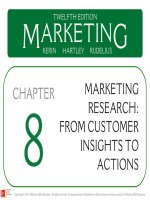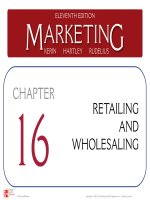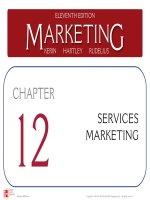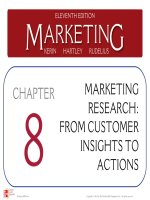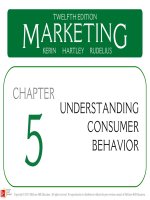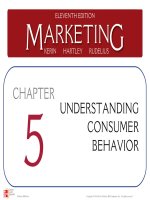Lecture Marketing (11/e): Chapter 22 – Kerin, Hartley, Rudelius
Bạn đang xem bản rút gọn của tài liệu. Xem và tải ngay bản đầy đủ của tài liệu tại đây (3.4 MB, 74 trang )
McGrawHill/Irwin Copyright © 2013 by The McGrawHill Companies, Inc. All rights reserved.
22-1
LEARNING OBJECTIVES (LO)
AFTER READING CHAPTER 22, YOU SHOULD BE ABLE TO:
LO1
Explain how marketing managers
allocate their limited resources.
LO2
Describe two marketing planning
frameworks: Porter’s generic business
strategies and synergy analysis.
LO3
Explain what makes an effective
marketing plan.
22-2
LEARNING OBJECTIVES (LO)
AFTER READING CHAPTER 22, YOU SHOULD BE ABLE TO:
LO4
Use a Gantt chart to schedule a series
of tasks.
LO5
Describe the alternatives for organizing
a marketing department
and the role of a product manager.
LO6
Explain how marketing ROI, metrics,
and dashboards relate to evaluating
marketing programs.
22-3
REACHING TODAY’S ON-THE-GO CONSUMER BY
BREAKING THE RULES AT “BIG G”
22-4
REACHING TODAY’S ON-THE-GO CONSUMER BY
BREAKING THE RULES AT “BIG G”
Cereal Industry Facts of Life
• 1 of 4 Brands Succeeds
• Decline in RTE Cereals
• High New-Product Risk
• Conflicting Consumer Intentions/Actions
22-5
REACHING TODAY’S ON-THE-GO CONSUMER BY
BREAKING THE RULES AT “BIG G”
Creative Initiatives Outside Cereals
• Eat-on-the-Go Products
Magic Brownie
• Single Portions
• Healthier Eating
• Cooking Convenience
22-6
LO1
MARKETING BASICS: DOING WHAT WORKS
AND ALLOCATING RESOURCES
FINDING AND USING WHAT REALLY WORKS
Strategy: Clear and Focused
Execution: Flawless Operations
• Kaizen
Culture: Performance-Oriented
Structure: Fast, Flexible, and Flat
22-7
MARKETING BASICS: DOING WHAT WORKS
LO1
AND ALLOCATING RESOURCES
USING SALES RESPONSE FUNCTIONS
Sales Response Function
Maximizing Incremental Revenue
Minus Incremental Cost
A Numerical Example of
Resource Allocation
• Year 1
• Year 4
22-8
FIGURE 22-1 A sales response function
shows the impact on sales at various levels
of marketing effort on annual sales revenue
22-9
MARKETING BASICS: DOING WHAT WORKS
LO1
AND ALLOCATING RESOURCES
USING SALES RESPONSE FUNCTIONS
Allocating Marketing
Resources in Practice
Share Points—Need Estimates of:
• Market Share
• Cannibalization
• Revenues
• Gross Margin
22-10
FIGURE 22-2 The actions in the strategic
marketing process are supported and
directed by detailed reports, studies, and
memos
22-11
LO1
MARKETING BASICS:
ALLOCATING RESOURCES
USING SALES RESPONSE FUNCTIONS
Resource Allocation and the
Strategic Marketing Process
Output Reports
22-12
LO1
THE PLANNING PHASE OF THE
STRATEGIC MARKETING PROCESS
THE IMPORTANCE OF METRICS IN MARKETING PLANNING
“If You Don’t Where You’re Going,
Any Road Will Get You There.”
Innovation Metrics
• Output Metric
• Input Metric
22-13
FIGURE 22-3 Metric ranked No. 1 by
respondents from organizations using more
than three innovation metrics
22-14
LO1
THE PLANNING PHASE OF THE
STRATEGIC MARKETING PROCESS
THE VARIETY OF MARKETING PLANS
Long-Range Marketing Plans
Annual Marketing Plans
22-15
LO2
THE PLANNING PHASE OF THE
STRATEGIC MARKETING PROCESS
MARKETING PLANNING FRAMEWORKS
Porter’s Generic Business Strategies
Cost Leadership Strategy
Differentiation Strategy
Cost Focus Strategy
Differentiation Focus Strategy
22-16
FIGURE 22-4 Porter’s four generic business
strategies involve combinations of
competitive scope and costs vs. product
differentiation
22-17
LO2
Campbell’s Soup and IKEA
Which of Porter’s generic business strategy does each use?
22-18
LO2
THE PLANNING PHASE OF THE
STRATEGIC MARKETING PROCESS
SYNERGY ANALYSIS
Synergy Analysis
• Marketing Synergy
• R&D-Manufacturing
Synergy
22-19
LO2
MARKETING MATTERS
A Test of Your Skills: Where are the Synergies?
1. Where are the marketing synergies?
2. Where are the R&D-manufacturing synergies?
3. What is the ideal market-product grid for a merger?
22-20
FIGURE 22-5 Market-product grids show
alternative strategies for a lawnmower
manufacturer
22-21
LO2
THE PLANNING PHASE OF THE
STRATEGIC MARKETING PROCESS
SYNERGY ANALYSIS
Market-Product Concentration
Market Specialization
Product Specialization
Selective Specialization
Full Coverage
22-22
FIGURE 22-6 The ideal merger for Great
Lakes to obtain full market-product
coverage
22-23
LO3
THE PLANNING PHASE OF THE
STRATEGIC MARKETING PROCESS
MARKETING PLANNING AND STRATEGY LESSONS
Guidelines for an Effective
Marketing Plan
• Set Measurable, Achievable Goals
• Use a Base of Facts and Assumptions
• Use Simple, but Clear and Specific Plans
• Have Complete and Feasible Plans
22-24
LO3
THE PLANNING PHASE OF THE
STRATEGIC MARKETING PROCESS
MARKETING PLANNING AND STRATEGY LESSONS
Guidelines for an Effective
Marketing Plan
• Make Plans Controllable and Flexible
• Find the Right Person to Implement
• Work Toward Concensus-Building
22-25


